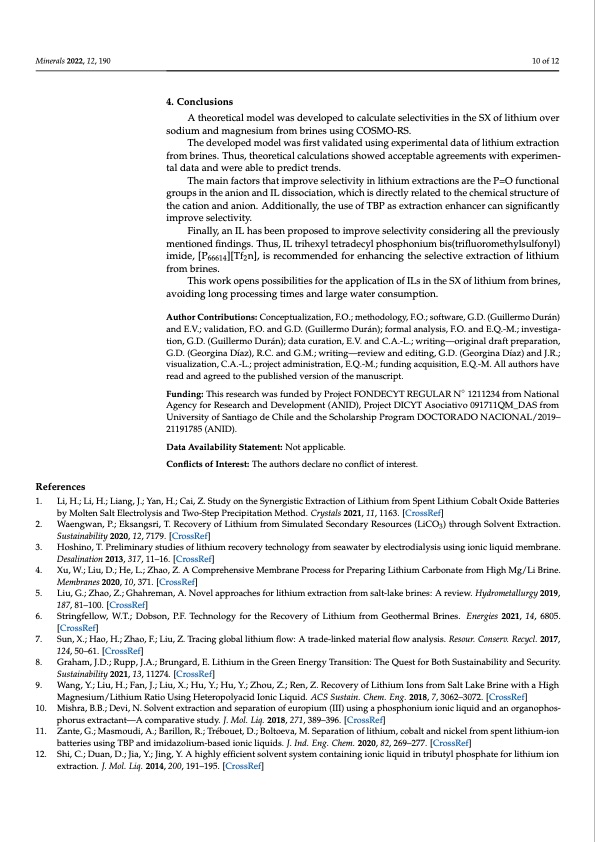
PDF Publication Title:
Text from PDF Page: 010
Minerals 2022, 12, 190 10 of 12 References 4. Conclusions A theoretical model was developed to calculate selectivities in the SX of lithium over sodium and magnesium from brines using COSMO-RS. The developed model was first validated using experimental data of lithium extraction from brines. Thus, theoretical calculations showed acceptable agreements with experimen- tal data and were able to predict trends. The main factors that improve selectivity in lithium extractions are the P=O functional groups in the anion and IL dissociation, which is directly related to the chemical structure of the cation and anion. Additionally, the use of TBP as extraction enhancer can significantly improve selectivity. Finally, an IL has been proposed to improve selectivity considering all the previously mentioned findings. Thus, IL trihexyl tetradecyl phosphonium bis(trifluoromethylsulfonyl) imide, [P66614][Tf2n], is recommended for enhancing the selective extraction of lithium from brines. This work opens possibilities for the application of ILs in the SX of lithium from brines, avoiding long processing times and large water consumption. Author Contributions: Conceptualization, F.O.; methodology, F.O.; software, G.D. (Guillermo Durán) and E.V.; validation, F.O. and G.D. (Guillermo Durán); formal analysis, F.O. and E.Q.-M.; investiga- tion, G.D. (Guillermo Durán); data curation, E.V. and C.A.-L.; writing—original draft preparation, G.D. (Georgina Díaz), R.C. and G.M.; writing—review and editing, G.D. (Georgina Díaz) and J.R.; visualization, C.A.-L.; project administration, E.Q.-M.; funding acquisition, E.Q.-M. All authors have read and agreed to the published version of the manuscript. Funding: This research was funded by Project FONDECYT REGULAR N◦ 1211234 from National Agency for Research and Development (ANID), Project DICYT Asociativo 091711QM_DAS from University of Santiago de Chile and the Scholarship Program DOCTORADO NACIONAL/2019– 21191785 (ANID). Data Availability Statement: Not applicable. Conflicts of Interest: The authors declare no conflict of interest. 1. Li, H.; Li, H.; Liang, J.; Yan, H.; Cai, Z. Study on the Synergistic Extraction of Lithium from Spent Lithium Cobalt Oxide Batteries by Molten Salt Electrolysis and Two-Step Precipitation Method. Crystals 2021, 11, 1163. [CrossRef] 2. Waengwan, P.; Eksangsri, T. Recovery of Lithium from Simulated Secondary Resources (LiCO3) through Solvent Extraction. Sustainability 2020, 12, 7179. [CrossRef] 3. Hoshino, T. Preliminary studies of lithium recovery technology from seawater by electrodialysis using ionic liquid membrane. Desalination 2013, 317, 11–16. [CrossRef] 4. Xu, W.; Liu, D.; He, L.; Zhao, Z. A Comprehensive Membrane Process for Preparing Lithium Carbonate from High Mg/Li Brine. Membranes 2020, 10, 371. [CrossRef] 5. Liu, G.; Zhao, Z.; Ghahreman, A. Novel approaches for lithium extraction from salt-lake brines: A review. Hydrometallurgy 2019, 187, 81–100. [CrossRef] 6. Stringfellow, W.T.; Dobson, P.F. Technology for the Recovery of Lithium from Geothermal Brines. Energies 2021, 14, 6805. [CrossRef] 7. Sun, X.; Hao, H.; Zhao, F.; Liu, Z. Tracing global lithium flow: A trade-linked material flow analysis. Resour. Conserv. Recycl. 2017, 124, 50–61. [CrossRef] 8. Graham, J.D.; Rupp, J.A.; Brungard, E. Lithium in the Green Energy Transition: The Quest for Both Sustainability and Security. Sustainability 2021, 13, 11274. [CrossRef] 9. Wang, Y.; Liu, H.; Fan, J.; Liu, X.; Hu, Y.; Hu, Y.; Zhou, Z.; Ren, Z. Recovery of Lithium Ions from Salt Lake Brine with a High Magnesium/Lithium Ratio Using Heteropolyacid Ionic Liquid. ACS Sustain. Chem. Eng. 2018, 7, 3062–3072. [CrossRef] 10. Mishra, B.B.; Devi, N. Solvent extraction and separation of europium (III) using a phosphonium ionic liquid and an organophos- phorus extractant—A comparative study. J. Mol. Liq. 2018, 271, 389–396. [CrossRef] 11. Zante, G.; Masmoudi, A.; Barillon, R.; Trébouet, D.; Boltoeva, M. Separation of lithium, cobalt and nickel from spent lithium-ion batteries using TBP and imidazolium-based ionic liquids. J. Ind. Eng. Chem. 2020, 82, 269–277. [CrossRef] 12. Shi, C.; Duan, D.; Jia, Y.; Jing, Y. A highly efficient solvent system containing ionic liquid in tributyl phosphate for lithium ion extraction. J. Mol. Liq. 2014, 200, 191–195. [CrossRef]PDF Image | Ionic Liquids for the Selective Solvent Extraction of Lithium

PDF Search Title:
Ionic Liquids for the Selective Solvent Extraction of LithiumOriginal File Name Searched:
minerals-12-00190-v3.pdfDIY PDF Search: Google It | Yahoo | Bing
Product and Development Focus for Infinity Turbine
ORC Waste Heat Turbine and ORC System Build Plans: All turbine plans are $10,000 each. This allows you to build a system and then consider licensing for production after you have completed and tested a unit.Redox Flow Battery Technology: With the advent of the new USA tax credits for producing and selling batteries ($35/kW) we are focussing on a simple flow battery using shipping containers as the modular electrolyte storage units with tax credits up to $140,000 per system. Our main focus is on the salt battery. This battery can be used for both thermal and electrical storage applications. We call it the Cogeneration Battery or Cogen Battery. One project is converting salt (brine) based water conditioners to simultaneously produce power. In addition, there are many opportunities to extract Lithium from brine (salt lakes, groundwater, and producer water).Salt water or brine are huge sources for lithium. Most of the worlds lithium is acquired from a brine source. It's even in seawater in a low concentration. Brine is also a byproduct of huge powerplants, which can now use that as an electrolyte and a huge flow battery (which allows storage at the source).We welcome any business and equipment inquiries, as well as licensing our turbines for manufacturing.| CONTACT TEL: 608-238-6001 Email: greg@infinityturbine.com | RSS | AMP |